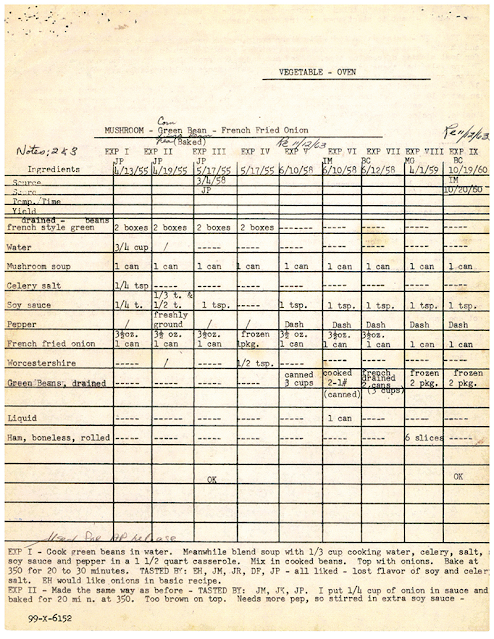Green Bean Casserole is one of the most popular side dishes to grace people's tables, particularly during the holidays. In fact, it's a holiday standard. And it's comfort food. The original recipe was invented during the days when canned and processed foods were stars of the kitchen because they were, as advertised by the manufacturers, good tasting and convenient. One usually finds recipes for Green Bean Casserole that call for canned cream of mushroom soup and canned green beans. Alternately, some folks use fresh green beans in combination with canned soup. Yes, it's quick and easy, but just think how much better a green bean casserole will taste if made with homemade sauce! And there's definitely a trend out there of taking the original recipe and augmenting it with fresher, homemade ingredients.
Look below at this add! Memories ... I wish I had a dollar (or five dollars, why not?) for each time I had opened a magazine to find the recipe in the picture below:
This is definitely a trip down memory lane. Such recipes announced the coming of the holidays!!!
The original recipe has an unbelievably high sodium content. And does canned mushroom soup really taste as good as a homemade sauce? Perhaps the answer is subjective. Comfort food is comfort food for a reason, and people don't like their comfort food to be messed with. As for me, I tried making everything from scratch and I never looked back. For one thing, I love a homemade roux! So I riffed off the original recipe.
Here we have a recipe that replaces the canned soup for a flavourful roux containing fresh mushrooms. The green beans are fresh and the topping is made from panko breadcrumbs. *Scroll all the way down to find out who invented Green Bean Casserole!
Ingredients:
2 pounds green beans, halved if you like, ends trimmed
olive oil at the ready
1 onion chopped1 large shallot or two small ones, minced
2 tablespoons parsley, chopped
1 pound mushrooms, sliced
3 cloves garlic, minced
3 tablespoon fresh thyme leaves3 tablespoons unsalted butter
3 1/2 tablespoons flour
Vegetable or chicken broth
3 cups of liquid: start with two cups heavy cream and add the liquid from the green beans. If you have less than three cups add some vegetable broth until you have the amount needed.
1/4 cup grated Pecorino Romano cheese
salt and pepper to taste
panko topping: for ingredients, see below
Topping:
2 cups unseasoned Panko bread crumbs
2 tablespoons butter chopped in tiny pieces. This is easily done when the butter is cold.
1 or 2 tablespoons olive oil
2 tablespoons grated Pecorino Romano cheese
- Combine all ingredients and mix well.
Directions:
- Braise the green beans: In a Dutch oven heat 2 tablespoons olive oil and add the chopped onion. Cook until the onion is translucent.
- Add the green beans, season with salt and pepper, and while stirring, cook for about three minutes.
- Add enough broth to cover the green beans and bring to a boil. Add the parsley and one tablespoon of the thyme. Lower the heat, cover the pot and let cool for about 45 minutes or until desired doneness is reached.
- Drain the green beans, reserving the cooking liquid if any is left. Set aside both green beans and cooking liquid.
- In a skillet, heat 2 tablespoons olive oil, lower the heat and add the shallot(s). Cook stirring for about two minutes.
- Add the mushrooms, garlic and thyme. Season with salt and pepper and while stirring occasionally, sauté for about five minutes until the mushrooms release their moisture and their liquid begins to evaporate.
- Add the butter and let melt. Add the flour and cook stirring the mixture for about one minute. Slowly add the three cups of liquid and bring to a boil stirring all the while until you have a thickened mixture.
- Add the Pecorino Romano cheese.
- Combine all the ingredients and arrange them in a baking dish, spreading them in an even layer.
- Sprinkle with the topping and bake at 400° F for about 20 minutes, until the cream is bubbly and the topping is crispy.
- This dish can be partially prepared one day ahead: cover the baking dish and refrigerate. The following day, bring the casserole to room temperature before baking.
- But wait!!! Who invented the Green Bean Casserole recipe??? Her hand-written recipe card is in the archives of the National Inventors Hall of Fame!
The inventor was Dorcas Reilly (1926-2018), born in New Jersey, resident of Haddonfield New Jersey, graduate of Philadelphia's Drexel University, and employee at the home economics department of Campbell's test kitchens in Camden, New Jersey. Reilly eventually became manager of Cambell's test kitchens. That's her in the photograph below (November 2002), at the National Inventor's Hall of Fame, when she donated her recipe card.
Mrs Dorcas Reilly being honoured at the Inventor's Hall of Fame (2002). She was a pioneer in her field, going to work in the 1950s and managing full-time employment along with marriage and motherhood.
Dorcas Reilly created green bean casserole in 1955 for an Associated Press feature about easy to make holiday dishes. She used ingredients that Americans tended to have on hand in the 1950s, such as green beans and Campbell's Cream of Mushroom soup. Another famous recipe of hers is the tuna noodle casserole. Which I love made with a homemade roux and topped with potato chips, yum!!!
Post War America liked inexpensive, fuss-free recipes. A large number of women were entering the workforce and therefore depended on recipes featuring quick, easy to make meals. Convenience cooking, which included canned and frozen foods, became all the rage. How do working women manage their kitchens these days?

































